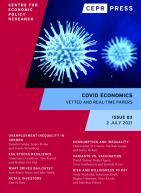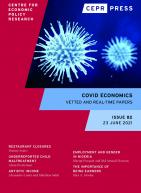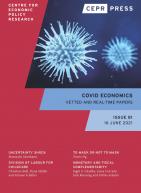
We test the theory that seller reputation moderates the effect of demand shocks on a seller's propensity to price gouge. From mid January to mid March 2020, 3M masks were priced 2.72 times higher than Amazon sold them in 2019. However, the difference (in price ratios) between a post-COVID-19 entrant and an established seller is estimated to be about 1.6 at times of maximum scarcity, that is, post-COVID-19 entrants price at approximately twice the level of established sellers. Similar results are obtained for Purell hand sanitizer. We also consider cumulative reviews as a measure of what a seller has to lose from damaging its reputation and, again, obtain similar results. Finally, we explore policy implications of our results.
Citation
Xu, L and L Cabral (2020), ‘Seller Reputation and Price Gouging: Evidence from the COVID-19 Pandemic‘, COVID Economics 12, CEPR Press, Paris & London. https://cepr.org/publications/covid-economics-issue-12#392514_392888_390410
This paper provides a critical review of models of the spread of the coronavirus (SARS-CoV 2) that have been influential in recent policy discussions. It notes potentially important features of the real-world environment that the standard models do not incorporate and discusses reasons why estimating critical parameters is difficult. These limitations may bias forecasts and lead forecasters to overstate confidence in their predictions. They also provide social scientists with opportunities to advance the literature and enable improved policies. This paper also discusses how optimal policies might depend on what is learned from new data and models.
Citation
Fisher Ellison, S, G Ellison, W Bossert, A Clark and C Avery (2020), ‘Policy Implications of Models of the Spread of Coronavirus: Perspectives and Opportunities for Economists‘, COVID Economics 12, CEPR Press, Paris & London. https://cepr.org/publications/covid-economics-issue-12#392514_392888_390411
What are the characteristics of workers in jobs likely to be initially affected by broad social distancing and later by narrower policy tailored to jobs with low risk of disease transmission? We use O/NET to construct a measure of the likelihood that jobs can be conducted from home (a variant of Dingel and Neiman, 2020) and a measure of low physical proximity to others at work. We validate the measures by showing how they relate to similar measures constructed using time use data from ATUS. Our main finding is that workers in low-workfrom-home or high-physical-proximity jobs are more economically vulnerable across various measures constructed from the CPS and PSID: they are less educated, of lower income, have fewer liquid assets relative to income, and are more likely renters. We further substantiate the measures with behavior during the epidemic. First, we show that MSAs with less pre-virus employment in work-fromhome jobs experienced smaller declines in the incidence of 'staying-athome', as measured using SafeGraph cell phone data. Second, we show that both occupations and types of workers predicted to be employed in low work-from-home jobs experienced greater declines in employment according to the March 2020 CPS. For example, non-college educated workers experienced a 4ppt larger decline in employment relative to those with a college degree.
Citation
Pilossoph, L, A Weinberg and S Mongey (2020), ‘Which workers bear the burden of social distancing policies?‘, COVID Economics 12, CEPR Press, Paris & London. https://cepr.org/publications/covid-economics-issue-12#392514_392888_390412
The Covid-19 pandemic has disrupted working life in many ways, the negative consequences of which may be distributed unevenly under lockdown regulations. In this paper, we construct a new set of pandemic-related indices from the Occupational Information Network (O*NET) using factor analysis. The indices capture two key dimensions of job task requirements: (i) the extent to which jobs can be adaptable to work from home; and (ii) the degree of infection risk at workplace. The interaction of these two dimensions help identify which groups of workers are more vulnerable to income losses, and which groups of occupations pose more risk to public health. This information is crucial for both designing appropriate supporting programs and finding a strategy to reopen the economy while controlling the spread of the virus. In our application, we map the indices to the labor force survey of a developing country, Thailand, to analyze these new labor market risks. We document differences in job characteristics across income groups, at both individual and household levels. First, low income individuals tend to work in occupations that require less physical interaction (lower risk of infection) but are less adaptable to work from home (higher risk of income/job loss) than high income people. Second, the positive occupational sorting among low-income couples amplifies these differences at the household level. Consequently, low-income families tend to face a disproportionately larger risk of income/job loss from lockdown measures. In addition, the different exposure to infection and income risks between income groups can play an important role in shaping up the timing and optimal strategies to unlock the economy.
Citation
Wasi, N, S Piyapromdee, P Porapakkarm and W Lekfuangfu (2020), ‘On Covid-19: New Implications of Job Task Requirements and Spouse''s Occupational Sorting‘, COVID Economics 12, CEPR Press, Paris & London. https://cepr.org/publications/covid-economics-issue-12#392514_392888_390413
Citizens’ compliance with measures enacted by health authorities can have an important effect on the state of public health, particularly during epidemics. How much can political leaders influence compliance with such measures? In this paper, we analyze this question in the context of Brazil, where the president Jair Bolsonaro disrespected the recommendations and measures implemented by health authorities during a country-wide pro-government demonstration that took place amid the COVID-19 outbreak. We conclude that Bolsonaro’s behavior increased the pace of COVID-19 diffusion. In particular, after the day of the manifestations, the daily number of new COVID-19 is 19% higher in cities that concentrate Bolsonaro’s voters as compared to cities that concentrate opposition voters. In particular, after the day of the manifestations, the daily number of new COVID-19 is 19% higher in cities that concentrate Bolsonaro’s voters as compared to cities that concentrate opposition voters. The impact is verified even in cities where no demonstration took place, which indicates that the quicker spread of COVID-19 was not only due to people agglomerating during the manifestation, but also due to the changed behavior of Bolsonaro’s supporters regarding social distancing measures. We directly test this later mechanism exploring an index of social isolation and find that citizens’ compliance with social distancing decreased among pro-Bolsonaro cities after the demonstrations.
Citation
Rettl, P and J Gagete-Miranda (2020), ‘Words can hurt: how political communication can change the pace of an epidemic.‘, COVID Economics 12, CEPR Press, Paris & London. https://cepr.org/publications/covid-economics-issue-12#392514_392888_390414
This paper provides evidence on the impact of major epidemics from the past two decades on income distribution. Our results justify the concern that the current pandemic could end up exerting a significant impact on inequality: past events of this kind, even though much smaller in scale, have led to increases in the Gini coefficient, raised the income shares of higher income deciles, and lowered the employment-to-population ratio for those with basic education compared to those with higher education. We provide some evidence that the distributional consequences from the current pandemic may be larger than those flowing from the historical pandemics in our sample.
Citation
Pizzuto, P, P Loungani, J Ostry and D Furceri (2020), ‘Will COVID-19 Affect Inequality? Evidence from Past Pandemics‘, COVID Economics 12, CEPR Press, Paris & London. https://cepr.org/publications/covid-economics-issue-12#392514_392888_390415
We draw on mobile application data from 74 countries to document the effects of the COVID-19 pandemic on the adoption of digital finance and fintech. We estimate that the spread of COVID-19 and related government lockdowns have led to between a 24 and 32 percent increase in the relative rate of daily downloads of finance mobile applications in the sample countries. In absolute terms, this equates to an average daily increase of roughly 5.2 to 6.3 million application downloads and an aggregate increase of about 316 million app downloads since the pandemic’s outbreak, taking into account prior trends. Most regions across the world exhibit notable increases in absolute, relative, and per capita terms. Preliminary analysis of country-level characteristics suggest that market size and demographics, rather than level of economic development and ex-ante adoption rates, drive differential trends.
Citation
Misha, M and J Fu (2020), ‘The Global Impact of COVID-19 on Fintech Adoption‘, COVID Economics 12, CEPR Press, Paris & London. https://cepr.org/publications/covid-economics-issue-12#392514_392888_390416
Tests are crucial to know about the number of people who have fallen ill with COVID-19 and to understand in real-time whether the dynamics of the pandemic is accelerating or decelerating. But tests are a scarce resource in many countries. The key but still open question is thus how to allocate tests across sub-national levels. We provide a data-driven and operational criterion to allocate tests efficiently across regions or provinces, with the view to maximize detection of people who have been infected. We apply our criterion to Italian regions and compute the shares of tests that should go to each region, which are shown to differ significantly from the actual distribution
Citation
Teschl, M, P Pintus, M Degoulet, S Luchini and C Baunez (2020), ‘Sub-National Allocation of COVID-19 Tests: An Efficiency Criterion with an Application to Italian Regions‘, COVID Economics 12, CEPR Press, Paris & London. https://cepr.org/publications/covid-economics-issue-12#392514_392888_390417


Covid Economics - Issue 82
- Restaurant Closures during the Pandemic: A Descriptive Analysis
- Underreporting Child Maltreatment during the Pandemic: Evidence from Colorado
- Covid-19 impact on Artistic Income
- COVID-19, Employment, and Gender: Evidence from Nigeria
- The Importance of Being Earners: Modelling the Implications of Changes to Welfare Contributions on Macroeconomic Recovery
